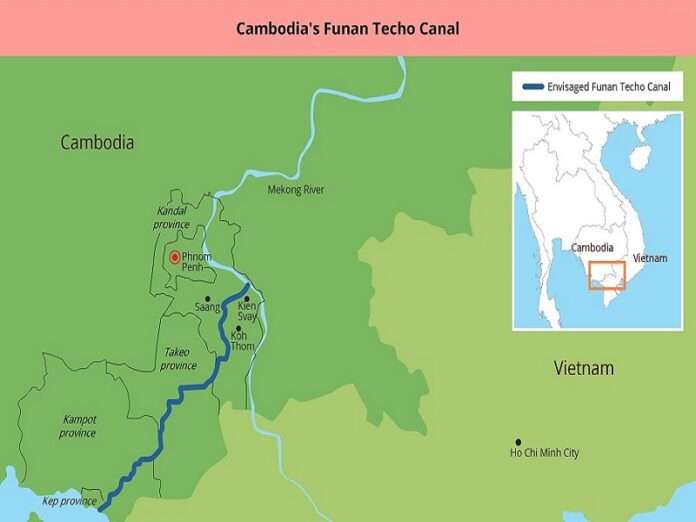There’s been a lot of talk this month about Cambodia’s planned Chinese-constructed Funan Techo Canal that’ll connect its riparian capital of Phnom Penh to the South China Sea instead of remaining dependent on Vietnamese ports in the Mekong Delta. China will entirely finance this $1.7 billion project through a Build-Operate-Transfer arrangement over the next 40-50 years, with construction expected to begin this year and conclude sometime in 2028. Here are five recent pieces about it for the reader’s interest:
* Vietnam Briefing: “Why Cambodia’s Funan Techo Canal Project is Worrying Vietnam”
* The Diplomat: “$1.7 Billion Cambodian Canal Project Draws Increasing Scrutiny”
* RT: “China wants to literally dig its way around geopolitical challenges”
* Fulcrum: “Vietnam’s Geopolitical Anxiety Over Cambodia’s Funan Techo Canal”
* Modern Diplomacy: “Navigating National Interest: Unpacking the Funan Techo Canal Project in Cambodia”
To summarize, Cambodia regards the region’s largest megaproject in recent history as a means for becoming a global textile leader by reducing costs and strategic dependence on historical rival Vietnam, while the latter is concerned about a new market rival and Chinese interests. China and Cambodia have always denied that the first plans to base any military forces in the second, but US think tanks continually claim that they’re cooking something up behind the scenes, including as recently as last week.
In principle, Cambodia is a sovereign state with the right to choose its own partners, and China’s offer is very attractive since it won’t cost Cambodia a cent and could drastically improve its socio-economic development within a single generation if this country plays its cards right. Its GDP growth rate is on pace to return to its 7% average that characterized the pre-pandemic era, and Cambodia’s cheap labor could combine with Chinese overseas investment to create a formidable market force in the future.
Reducing export costs via the Funan Techo Canal and preemptively averting the scenario of Vietnam weaponizing its strategic leverage over Cambodia like Fulcrum reminded readers that it last did during a feud in 1994 are crucial to its planned rise as a global textile leader. In practice, however, Cambodia’s growing closeness to China can serve as the pretext for more American fearmongering campaigns aimed at stirring up trouble for Beijing in the South China Sea and especially with Hanoi.
As RT’s Timur Fomenko noted, “the competition between Beijing and Hanoi is a complex and intermingled one, but far from hostile. The two nations have differing and conflicting objectives, but also many complimentary ones, for which it benefits them both to maintain a cordial status quo.” This explains why it’s starting work on two high-speed rail lines to China in spite of their security dilemma over disputed maritime territory and Vietnam’s suspicions of Chinese intentions in Cambodia.
History casts a long shadow over everything though. Fulcrum also reminded readers that Vietnam’s Nguyen Dynasty absorbed Cambodia’s Mekong Delta territory in the 18th century, which later laid the basis for the territorial dispute that served as the pretext for Vietnam’s 1979-1989 intervention in Cambodia. It was this conflict that turned festering Sino-Vietnamese hostility into a month-long conventional war from February-March 1979, which was Beijing’s last formal military conflict.
Plenty has changed over the past 40 years, but the ghosts of the past still influence present-day perceptions among these three parties, with the US having an interest in riling everyone up. Vietnam has done an excellent job multi–aligning between Great Powers à la the Indian model by balancing between Russia and the US all the while profiting from China in spite of their tensions. At the same time, however, the US interest is to worsen the Sino-Vietnamese security dilemma by fearmongering about Cambodia.
To that end, circulating rumors about supposedly secret Chinese-Cambodian military plans is meant to convince Vietnam to play a more active role in containing China in its eponymous South Sea. The US wants Vietnam to play a complementary role to the Philippines in this respect even though hosting American forces is ruled out for historical and domestic legal reasons. The envisaged end game is to have these two ASEAN nations squeeze China in that body of water from the western and eastern vectors.
Explaining these plans shouldn’t be spun as endorsement, nor as implying that they’ll succeed. The only intent is to inform readers of what the US’ interests are and how it’s expected to advance them. The Funan Techo Canal is a daring geo-economic project that could revolutionize Cambodian society within a generation if this country plays its cards right, but it also runs the risk of playing into the US’ anti-Chinese fearmongering narrative if it’s spun to manipulate Vietnam into more muscularly containing China at sea.






